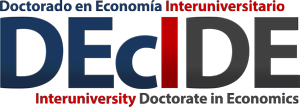- Referencia: Jurado-González, J. y Gómez-Barroso, J.L.: “Economic complexity and information society paradigms: a hybrid contribution to explain economic growth”. 2022, Technological and Economic Development of Economy, 28(6), 1871-96.
Abstract In the last decades, the Information Society (IS) paradigm has brought together various research lines related to the diffusion and adoption of Information and Communication Technologies (ICTs) and their contribution to economic, social and human development. On the other hand, other research lines have recently explored the phenomenon of Economic Complexity (EC), providing new…
- Referencia: Domínguez Sánchez, M. y Fonfría, A.: “Measuring Productivity of the Spanish Defence Industry”. 2022, Defence and Peace Economics (online).
Abstract This paper analyses the determinants of productivity and its evolution over time, of the main sectors that conform the Spanish defence industry. The analysis is based on the selection of factors that describe the situation of the industrial sectors. As inputs, the following are used: direct sales to the Spanish Ministry of Defence and…
- Referencia: Amassaghrou, S., Gutiérrez-Hita, C. y Zhukova, V.: “An assessment of the liberalization and the evolution of competition in the Moroccan mobile market”. 2022, Telecommunications Policy, 46(5), 1-16.
Abstract This paper analyses the liberalization process of the Moroccan mobile market since the beginning of the 21 st century. Our database ranges from 2004 to the end of 2020. First, operators’ market shares are presented and analysed. Second, we build concentration indexes and other indicators of competitiveness. Finally, we conduct an econometric analysis to…
- Referencia: y Jurado-González, J.: “What became of the Information Society and development? Assessing the Information Society’s relevance in the context of an economic crisis”. 2016, Information Technology for Development, 22, 3.
Abstract Although it is widely assumed that the development of an Information Society is an engine for sustainable economic growth, this often remains more of an assumption than a demonstrable outcome. A critical analysis of that link is much needed, and particularly pertinent during times of crisis where it can be even more tested. To…
- Referencia: Buendía Azorín, J.D., Martínez Alpañez, R. y Sánchez de la Vega, M.M.: “A new proposal to model regional input–output structures using location quotients. An application to Korean and Spanish regions”. 2022, Papers in Regional Science (in press).
Abstract This paper is based on the use of Flegg’s location quotients (FLQ) and proposes a novel procedure for the estimation of the unknown parameter δ in regions with and without input–output frame availability. Applied to data for the Korean regions for the year 2015, firstly the determination of the optimal δ is addressed by…
- Referencia: Martínez-Carrión, J.M., Román-Cervantes, C. y Candela-Martínez, B.: “Entre los más altos de España. El estado nutricional en las Canarias occidentales: cohortes masculinas de 1860-1915”. 2018, Nutrición Hospitalaria, 35, Extra (5), 39-46.
Abstract Objetivo: analizamos la dinámica del estado nutricional en las Canarias con datos de la altura masculina durante la segunda mitad del siglo xix y su dimensión en el contexto español.Métodos: con datos del reclutamiento militar, hacemos una estimación de la talla promedio masculina en edades de 19-21 años por cohortes de nacimiento para el…
- Referencia: Ramon-Muñoz, R., Ramon-Muñoz, J.M. y Candela-Martínez, B.: “Sibhsip size, height and cohort selection: a methodological approach”. 2021, International Journal of Environmental Research and Public Health, 182, 3369.
Abstract This article deals with the historical relationship between the number of siblings in a family or household and height, a proxy for biological living standards. Ideally, this relationship is better assessed when we have evidence on the exact number of siblings in a family from its constitution onwards. However, this generally requires applying family…
- Referencia: Candela-Martínez, B., Ramallo-Ros, S., Cañabate, J. y Martínez-Carrión. J.M.: “Month of birth and height. A case study in rural Spain”. 2022, Economics and Human Biology (in press).
Abstract Introduction.- Season of birth correlates to a wide range of health conditions throughout life measured by anthropometrics. This study explores whether the month of birth and weather during gestation influence male adult height, based on Spain’s rural population before the end of the modernization process. Methods.- The database of heights (N = 16.266) is composed of…
- Referencia: y Candela-Martínez, B.: “Growing taller unequally? Adult height and socioeconomic status in Spain (Cohorts 1940–1994)”. 2022, SSM - Population Health (in press).
Abstract Socioeconomic inequalities and their evolution in different historical contexts have been widely studied. However, some of their dimensions remain relatively unexplored, such as the role played by socioeconomic status in the trajectory of biological living standards, especially net nutritional status. The main objective of this article is to analyze whether the power of socioeconomic…
- Referencia: y Makeienko, M.: “Symbolic Analysis Applied to the Specification of Spatial Trends and Spatial Dependence”. 2020, Entropy, 22(4), 466.
Abstract This article provides symbolic analysis tools for specifying spatial econometric models. It firstly considers testing spatial dependence in the presence of potential leading deterministic spatial components (similar to time-series tests for unit roots in the presence of temporal drift and/or time-trend) and secondly considers how to econometrically model spatial economic relations that might contain…

